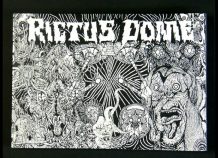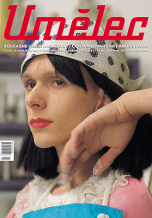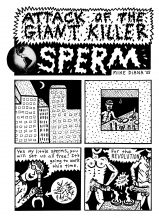| Umělec 2003/2 >> Alexander Györfi: The Art of Friendsploitation | Просмотр всех номеров | ||||||||||||
|
|||||||||||||
Alexander Györfi: The Art of FriendsploitationUmělec 2003/201.02.2003 Oystein Aasan a Halvor Kyrre Haugen | artist | en cs |
|||||||||||||
|
The Artist as Producer (after Walter Benjamin)
In his text “The Artist as Producer,” first published in 1978, Dan Graham presents a compressed history of pop music. The title of the text alludes, of course, to Walter Benjamin’s 1934 lecture “The Author as Producer.” The word producer does not, however, have the same meaning in the two texts. In Benjamin’s text, it refers to a social identity, defined by its position within the production apparatus, and that has the proletarian worker as its ultimate referent; in Graham’s text, the word denotes a professional title — the producer of the music business. What the field of music seems to have offered Graham as an artist is a hyperreal, larger-than-life model of art production, in which not the immediate producer (the musician, whose art world equivalent would be the stupid painter), but rather the mediator is the true creator. The protagonists that incarnate the producer in Graham’s narrative make up a paternal line of “urban Jews” that culminates in the coming of Malcolm McLaren — the demiurgic puppet master who cleverly pulls the strings from behind the scene of the rock’n’roll spectacle, making the pop star dance like a little homunculus. You’ve Come a Long Way, Baby (after Fatboy Slim) Alexander Györfi’s work may be seen as both an exploration and an exploitation of musical modes of production. Through the production of records and music-videos he uses the standard formats of the music industry as a matrix for his own praxis as an artist. In an interview, Györfi has explained how his present work came out of a desire to combine his artistic practice with his love of music. Originally trained as a painter, he did gigs on the side, playing in bands and orchestras. In this situation, combining the two activities into a consistent ouvre presented itself as a conflict between two different specialist skills. Eventually, the way Györfi has succeeded in integrating these two interests has been by emulating the professional role of the music producer. In 1997 Györfi founded his own record label, Pimui Recordings, which has served as the platform for his later projects. I’ll give you television (after David Bowie) The show “A-Side (China Girl)”, presented at Play Gallery in Berlin this summer, could be read as a small-scale model of music production which revolved around the release of a single. The single, produced by Györfi, featured cover versions of two classic pop songs, both originally released in 1977: the title track, written by Iggy Pop and David Bowie, and the Stranglers’s “Hanging Around.” In a sparingly designed lounge, the visitors were invited to sit down on plywood boxes arranged around a listening station where they could listen to the single through a set of head phones. The walls were covered with white canvas backdrops that featured stylized images of musical means of production: a reel-to-reel tape recorder, an electric guitar (flying V-style), and a microphone in its stand. In a second room, the video “I’ll Give You Television” was shown as a wall projection. The video starts off with a rehearsal scene from the recording session of “China girl.” The female lead singer is seen yelling incoherent lines from the tune into a microphone, appearantly getting instructions from the producer along with the rhythm track through her headphones. The second part is presented as a music video. Shot on location at an Asian fast food restaurant in Berlin, it stars the girl — a Caucasian — introduced in the first scene as she performs the post-colonial anthem of Pop&Bowie in a soft, little-girl’s voice in front of an Asian waitress. The casting and the trivial exotica that the setting represents adds a second-degree irony to the lyrics’ play with racist and chauvinist themes. Cross-checking the credits from the video with those on the cover of the single, it appears that the China-girl of the video stars as the singer on the single’s B-side, her scruffy vocals not entirely unlike those of the male vocalist on the original version. Returning to the turntable in the first room, the simple operation of flipping between the A- and B-side becomes caught up in the videos play with switched identities. So You Wanna Be a Rock’n’Roll Star? (after the Byrds) The theme of supplying amateur performers with the means to realize their will to fame within the small-scale system of art is a recurrent one in Györfi’s art. In a project at Kunstverein Ludwigsburg titled Pimui Mobil Studio, Györfi rigged up a complete home-recording studio for public use. The video “Boys don’t Cry” offers another example of both how Györfi offers his collaborators a few minutes of Warholian fame. Here, a music video, complete with the MTV logo in the upper right corner of the picture, introduces us to a band of three girls. In front of a small but enthusiastic audience they mime to the play-back of their own recording (produced by Alexander Györfi) of the Cure song which gives the work its title. The obvious irony of having a girl sing Robert Smiths’ lyrics about a boy’s fear of losing face by femininely breaking into tears and the amateurishness of the performance is played up against the slick professionalism that the appropriated logo represents. In the second part of the video we see the three girls lined up in front of the camera as the music-video in which they starred is played back to them. As the girls watch themselves playing the roles of pop-stars we see the expressions on their faces flicker between awe and embarrassment — here, Györfi’s miniature galaxy of pop-stardom contracts further into a small feed-back loop. In the video titled “La ballade des gens heureuex” (“The Ballad of Happy People”), Györfi uses a strategy often found in his previous art production. He involves a number of friends into the project, and they improvise along the lines in an open and structure-free framework. La Ballade follows the structural formula of a movie trailer, splicing a sequence of significant episodes taken from a full-length movie. In this case, however, the movie, for which the trailer is an advertisement, does not exist. By inverting the strategy of film promotion, Györfi creates a situation in which fulfillment can only take place in our imagination. In the video “Beatballs and Flukes,” a theatrical staging of a picnic is transformed into a production site for electronic music — sans electronics, or at least, so it seems at first sight. The mise-en-scene presents us to a poppish pastoral: against a backdrop of puff-clouded blue skies, the actors take the astroturf-covered stage one by one, each of them stomping out a rock-steady beat with a quotidian object; the sound from bouncing balls, a tennis racket and the clapping noise from two frogman’s feet come together and produce a drum track with the precision of a rhythm box. After a while, however, it becomes clear that the rhythm in fact has an electronic source and that the no-tech appearance is as much a fake as the painted blue skies on the backdrop — but just this is a kind of fake that is constitutive to the reality of video-production. The project “Pimui Home Recordings” offers a humoristic visualization of the solitary aspect of bed-room productions in the age of multi-track recording. In a series of five music videos, an equal number of trios, each of them made up of a single person by means of the simple film-trick of making multiple exposure shots, perform their home-spun pop ditties with dead-pan commitment. “Where are my friends? Where is my band?” sings one of the triplets mournfully, accompanied by his two identically clad and apparently equally lonesome clones. The Artist as Postproducer (after Bourriaud) Nicolas Bourriaud’s recent book Postproduction gives a theoretical account of contemporary artist’s employment of the strategies of music production which seems to fit Györfi’s artistic practice like a glove (indeed, Györfi’s work is mentioned in the book, and he has exhibited at the Palais de Tokyo in Paris which is headed by Bourriaud). Like the computer programmer or the Deejay, Bourriaud’s artist as postproducer “samples,” “dubs,” “recodes” and “reprograms” the givens of culture: “preexisting works or formal structures.” Ultimately, the artist as postproducer controls the switches on the grand console of culture, plugged into the power station of the real: s/he is a “remixer of realities.” Bourriaud is something of a remixer of cultural theory in his own right: in his book, Benjamin’s voice may be heard echoing in Bourriaud’s argument — filtered, as it were, through the vintage Echoplex® delay-pedal of Michel de Certeau: “[the artist as postproducer] contribute[s] to the eradication of the traditional distinctions between production and consumption”; the artist as postproducer may be seen as the last figure in a long line of ‘artists as...’ . Spanning from the productivist artist as engineer, via Alan Kaprow’s the Artist as a Man of the World and Kosuth’s the Artist as Anthropologist to Hal Foster’s the Artist as Ethnographer, its various inflections have been called upon in order to locate the artist in a position more in sync with his/her times through the import of another professional identity. Given the centrality of music within the great spectacle of our culture, it is natural then that artists in their quest for role models should be attracted to the central agents of music production. But of course, artist’s long-lasting fascination with music isn’t limited to using the music production analytically as an abstract model or as a general mode of production. It may for example be motivated by the forever green longing to join their friends in a rock’n’roll band. P.S. I Love You (after Elvis Costello) Friendship may be seen as the second leitmotif of Györfi’s work alongside music. Or perhaps one might even say that friendship is the underlying motive that informs his involvement both with art and with music? As a producer of art, Györfi introduces the amateur performances of his friends into the professionalized circuits of the art world through the medium of his own professional status as an artist. Yet, his way of producing his amateur pop-stars always seems to be characterized by the mutual trust of friendship. Through the figure of friendship, the role of the amateur may be said to mark Györfi’s way of playing his own professional role. The amateur is s/he who loves. Not with the obsessive devotion that characterizes the fan, whose love verges on a complete identification with its object and that, as the term fan (from fanatic) indicates, is exalted — ultimately to a point where it threatens to consume it. In contrast, then, the loving amateur demonstrates a certain reserve in relation to his/her object of affection. A reserve that signifies respect, but which also keeps the possibility of critique open. An expanded version of a review by Aasan and Haugen, originally published in the Berlin art magazine Neue Review.
01.02.2003
Рекомендуемые статьи
|
|||||||||||||
|
04.02.2020 10:17
Letošní 50. ročník Art Basel přilákal celkem 93 000 návštěvníků a sběratelů z 80 zemí světa. 290 prémiových galerií představilo umělecká díla od počátku 20. století až po současnost. Hlavní sektor přehlídky, tradičně v prvním patře výstavního prostoru, představil 232 předních galerií z celého světa nabízející umění nejvyšší kvality. Veletrh ukázal vzestupný trend prodeje prostřednictvím galerií jak soukromým sbírkám, tak i institucím. Kromě hlavního veletrhu stály za návštěvu i ty přidružené: Volta, Liste a Photo Basel, k tomu doprovodné programy a výstavy v místních institucích, které kvalitou daleko přesahují hranice města tj. Kunsthalle Basel, Kunstmuseum, Tinguely muzeum nebo Fondation Beyeler.
|








































 New book by I.M.Jirous in English at our online bookshop.
New book by I.M.Jirous in English at our online bookshop.
Комментарии
Статья не была прокомментированаДобавить новый комментарий